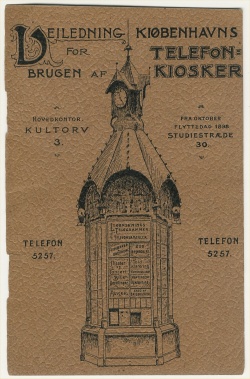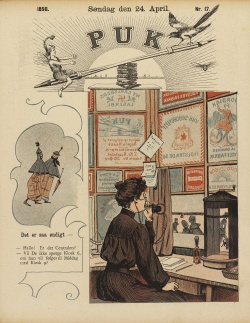The Telephone Kiosk - and the Popular Breakthrough of the Telephone
01. Sep. 2005

It appears from these instructions from 1898 that the telephone kiosks were unable to phone each other directly. All mutual communication had to be via the exchange, which also explains the picture below.
The Year of Expectation
In 1877 Graham Bell presented his telephone in Europe and the invention was mentioned in the media everywhere - also in Denmark. The expect-ations from the press were great; it was even imagined that the telephone would become the ultimate mobile means of communication:
Put the receiver in your pocket and connect it at any telegraph station when you need to get in touch with the missus at home!
The confectioners sold telephone cakes in 1877 whereas the mobile phone, as it is a well-known fact, did not emerge for another century. It was not until the 1890's that the media and the public in general took an interest in Bell's invention again.
Exclusive Technology
A Danish telephone company was, however, es-tablished already in 1879, and an international one in 1881. The Danish company, Kjøbenhavns By- og Hustelefon (Copenhagen Town and House Tele-phone), aimed at public telephone stations and be-gan also to offer installation of telephone lines to private customers. This was, however, stopped by intervention of C.F. Tietgen when he chose to sup-port the American Bell International Telephone Company in their establishment of a telephone company in Copenhagen. It started operating on 15th January 1881. Before the end of 1882 it was taken over by a limited company founded by Tietgen: Københavns Telefonselskab (KTAS).
Bell's company aimed at customers from the economical elite, the financially strong business sector, whose rallying ground was the Copenhagen Stock Exchange. With no competition the company could fix the subscription so that investments were soon recovered. This strategy was continued by KTAS. The telephone came to Copenhagen as an exclusive acquisition for the well-off. In 1889, KTAS thus had only 1,487 subscribers out of the Copenhagen population of more than a quarter of a million people - and on Zealand outside Copenhagen totally 270 subscribers were registered. The number of telephone subscribers in Jutland, on Funen, and the other Danish islands was equally modest.

"It is so Lovely" - from PUK no. 17 of 24th April 1898. The Royal Library.
- Hello! Is it the exchange?
Would you please ask Kiosk 6 if she would like to join Kiosk 9 for lunch?
A Public Breakthrough
During the 1890's the picture began to change. The telephone companies had to position themselves to obtain approval (concession) from the state to continue operations, and the strategy was changed: In order to get more customers possibilities of cheaper subscriptions were introduced, e.g. party-line telephones by which several subscribers shared the same line. The mounting of public tele-phones and call boxes were likewise accelerated. In 1895 the company A/S Kjøbenhavns Telefon-Kiosker was established. The concept was known from Paris in particular and implied erection of small buildings from which a comprehensive se-lection of articles and services were offered: News-papers, magazines, theatre tickets, insurance pol-icies, stamps, postcards, as well as letter, parcel, and telegraph messenger services, etc. could be bought - and most important: The telephone could be used at a charge and made it possible to get in contact with any of the at that time about 4,000 sub-scribers in Copenhagen and environs.
The architect Fritz Koch (1857-1905) delivered the designs for the first kiosks. On 1st June 1896 kiosk no. 1 opened at Kongens Nytorv, and before the end of the year there were totally 10 kiosks situated in central places of the capital. People found them decorative - and useful. They were a success, also from point of view of the telephone companies. A great deal of the credit for the public breakthrough of the use of telephones in the busy city around the year 1900 is no doubt attributable to the telephone kiosk.
Satire Tells Tales
The news of the plans for telephone kiosks brought back telephone jokes to the pages of the satire magazines after many years of almost total silence about the apparatus. From that time onwards there is not one single volume of the bourgeoisie's popular satire magazines that does not feature at least one telephone joke, and the telephone also entered revue texts and songs.
The number of subscribers increased in a completely different rapid tempo during the following 20 years - and satire tells tales about the public breakthrough, which we exemplified in the article "Tele-phone Trouble" by Martin Johansen in MuseumsPosten 2005-2.
This article may be copied or quoted with MuseumsPosten, Post & Tele Museum as source.
Comment this article
Only serious and factual comments will be published.